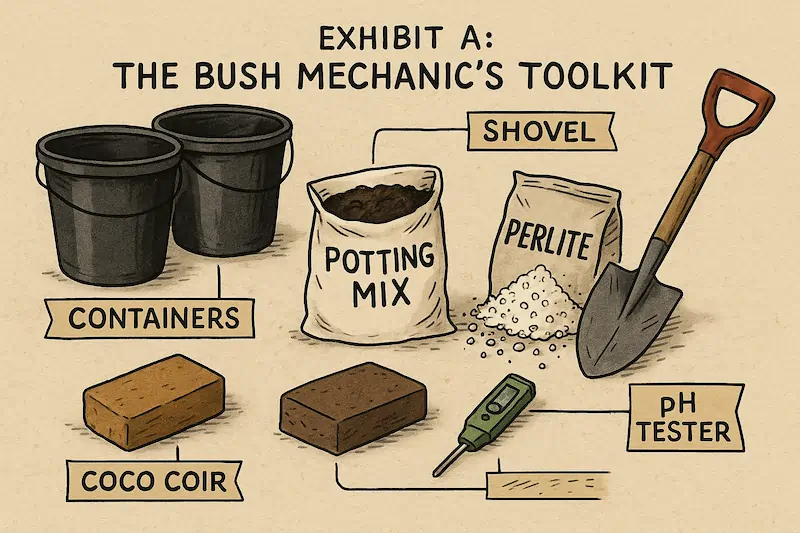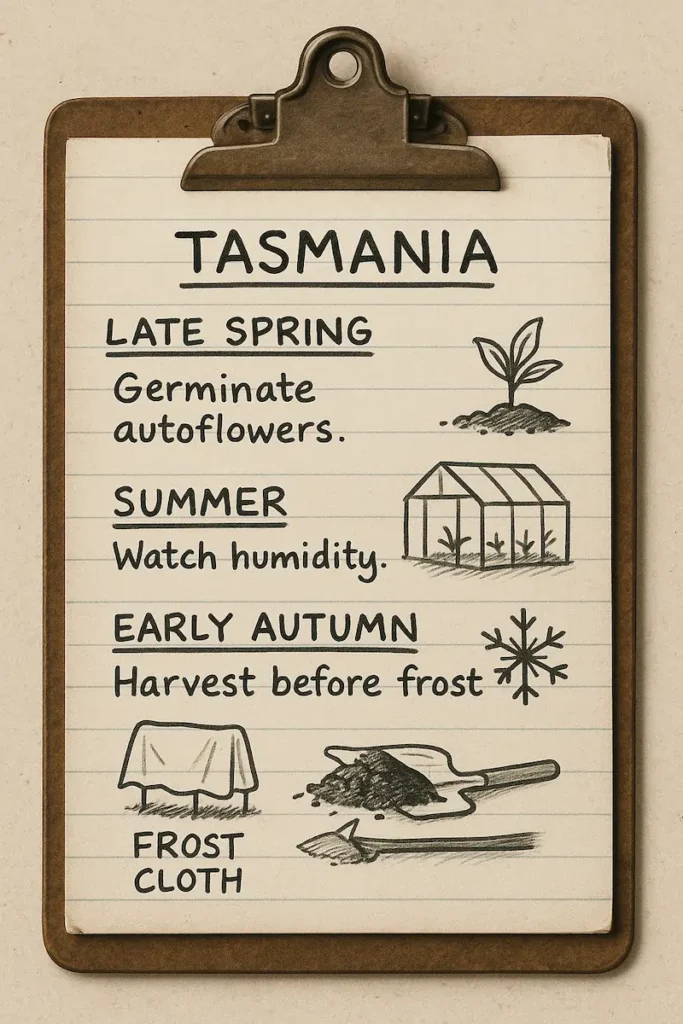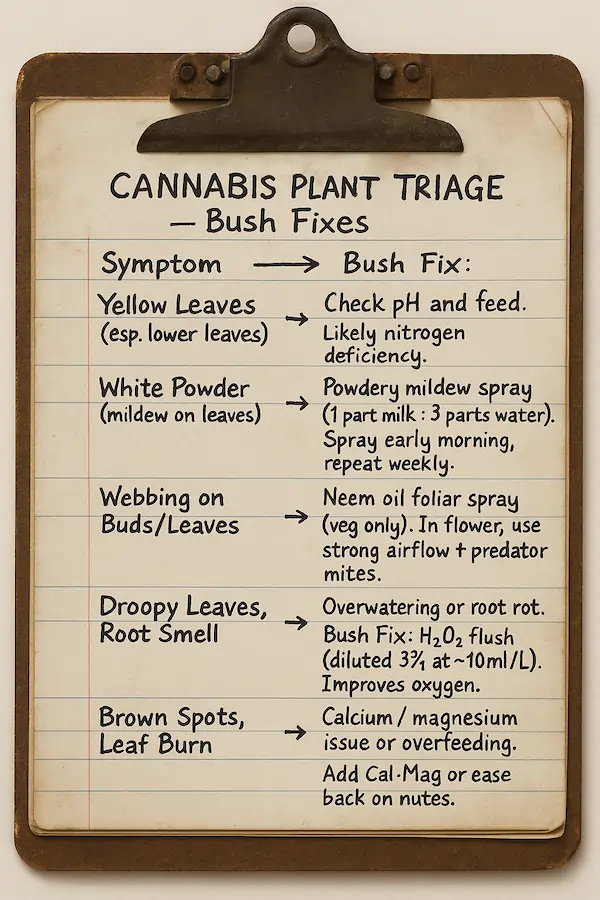Case File No. 27-AUS01
Subject: Outdoor Grow Operations (Australian Front)
Persons of Interest: The Sun, Bludger Pests, The Southern Cross
Investigating Officer: Matty Ridge
G’day, and welcome to my patch.
You’re thinking of growing cannabis outdoors in Australia? Good on ya. The sun is free, the air is clean, and the rewards are bloody magnificent. But let me give you the hard truth: this isn’t a pristine grow tent. This is a battlefield. The sun wants to cook your plants like a snag on the barbie, the insects are on a mission to eat them, and the weather changes its mind more often than your missus picking a restaurant.
This guide isn’t a textbook. It’s a set of lessons learned the hard way, with dirt under my fingernails and a few lost battles under my belt.
Exhibit A: The Bush Mechanic’s Toolkit
Forget fancy gadgets. A proper outdoor setup is about getting the basics right.
- Containers: Don’t start a seedling in a full-sized drum. Start it small, then move it up. I like a 5-gallon bucket for a bit of control, then once she’s strong enough, she can go in the ground.
- Soil: The cannabis industry is full of blokes trying to sell you miracle dirt. My advice? Start with a quality potting soil as your base. If you want to get fancy, mix in some coco coir or perlite. They lighten the soil and keep it from getting waterlogged.

Exhibit B: The Right Strain for the War
Picking your seeds is the first, and most important, call you’ll make. You need a strain that can handle the Australian spirit—resilient, adaptable, and tough as old boots. Don’t muck about with non-feminised seeds unless you’re keen on a 50% chance of a useless male plant. Get feminised seeds; they’re the ticket.
Here are a few troopers I’ve sent into the Australian battlefield. You can get a full intel report on these from our seed bank:
- Blue Dream: An absolute legend. This Sativa-dominant hybrid is tough and handles the heat like a true Aussie. Gives a solid yield, too.
- Green Crack: If you’re in the hotter regions, this plant is a champion. It thrives in the sun and punches out a massive yield.
- Gold Leaf: This one is a workhorse. It doesn’t complain and gets the job done. A solid all-rounder.
Exhibit C: Matty’s Month-by-Month Field Notes
This is the most important part of the manual. What works in one part of this massive country will get you buggered in another.
Tasmania (Cool Temperate / Alpine South)
Down here, the season is shorter than a politician’s memory. You’ve got from late Spring to early Autumn, and that’s it. You’re fighting frost in both the Spring and the Autumn, so greenhouses or cheap frost cloth are non-negotiable. Autoflowers are your best mate here; they don’t care about daylight hours and can finish before the frost monster strikes. Quick-flowering Indica-dominant strains are also a safe bet. Even clear plastic sheets over your plants can buy you those few extra weeks that make or break a harvest.
Matty’s Timeline:
October – November: Start seeds indoors or in a greenhouse to dodge late frosts. Autoflowers can go straight into small pots under cover, then be hardened off outdoors once nights warm up.
December – January: Plants hit their stride. Some growers even squeeze in two auto runs (Oct–Jan, then Jan–Apr) if the season’s kind.
March: Harvest before the cold snaps return. Don’t risk it—frost cloths or plastic covers can save a crop, but better to finish early.

The Coastal East Coast (Byron → Sydney → SE QLD)
This is the Sativa playground. You get long, warm seasons, so you can plant early and go for big yields. But don’t get cocky. The humidity is your enemy. You’ll be on constant mold patrol, and the pests down here are as dedicated as a footy fan on a Saturday.
Matty’s Timeline:
September: The prime time to start your photoperiod seeds. Get them going early to maximise veg time.
December – January: Your plants will be in peak veg. You’ll be busy with training and managing humidity.
April: Harvest time. By now, your buds should be dense and ready to go.
The Tropical North (e.g., Cairns, Darwin)
You’re in a survival zone. The heat and humidity are your main enemies. Start your grow season in Spring and pick mold-resistant Sativa strains. Focus on drainage. Add extra perlite or gravel to the bottom of your pots to make sure your roots don’t drown in the wet season.
Matty’s Timeline:
August – September: Start your grow season as the wet season kicks in, allowing your plants to build mass.
January – February: Manage pests and mold during the peak humidity. Heavy airflow is non-negotiable.
March – April: Harvest before the heaviest heat of the year sets in.
The Arid Outback (e.g., Alice Springs)
This land wants to kill your plant. Water is your biggest concern. You’ll need to grow near a reliable water source. Use a shade cloth to protect your plants from the harshest sun, or build a simple shade structure out of a tarp. Use soil amendments to help retain moisture.
Matty’s Timeline:
September: Start your seeds to get them established before the summer heat. Autoflowers work well here.
December – February: This is peak heat. Provide ample shade and check on water daily.
March – May: Harvest. Enjoy the cooler weather and the fruits of your labor.
The South-West (Perth & Margaret River)
The Mediterranean climate is almost perfect—mild winters and hot, dry summers. The mold risk is lower here than in the East. Your main fight will be a water-related one; water restrictions and long, dry spells are the biggest challenge.
Matty’s Timeline:
September – October: Start your seeds. The mild weather is perfect for early veg growth.
December – February: Manage your water use during the hot, dry summer months. Top-dressing with mulch helps.
March – April: Harvest. Your plants should be plump and ready before the weather turns.
Matty’s Quick Reference Calendar
Can’t be stuffed scrolling? Fair enough. Here’s a consolidated guide for you to save, print, or tattoo on your arm. Don’t get caught with your pants down.
| Region | Start Seeds | Transplant | Harvest |
|---|---|---|---|
| Tasmania | Oct–Nov (indoors) | Dec–Jan | Mar |
| East Coast | Sept | Oct–Nov | Apr |
| Tropical North | Aug–Sept | Oct | Feb–Mar |
| Outback | Sept | Oct | Mar–Apr |
| South-West | Sept | Oct | Apr |
Exhibit D: The Bush Mechanic’s Triage
Don’t overcomplicate this. Your plant is hungry, but you don’t need a fancy lab to feed it.
- pH Check: Listen up. Your plant won’t be able to eat if the pH of your soil is off. Don’t worry about the scientific stuff, just know that you want your soil between 6.0 and 7.0. If your leaves are showing nutrient lock-out even though you’re feeding it, a cheap pH test kit is your best friend.
- Veg Stage: Your plant is building its house. It needs nitrogen. Think leafy greens, chicken manure, or a good veg mix.
- Flower Stage: Your plant is building flowers. It needs phosphorus and potassium. Think bone meal, worm castings, or a bloom-specific mix.
You can learn all about it in my full guide on Case File: Leaf Forensics: Decoding Your Plant’s SOS Signals.

Exhibit E: Bush Mechanic’s Tricks
You can either let your plant grow wild, or you can tame it. Here’s how I do it.
- Topping: It feels wrong, but it’s essential. Cut the main stalk to create two new ones. It gives you a bushier plant and more colas.
- LST (Low-Stress Training): Don’t be gentle. You bend your plant until it screams, then you tie it down, forcing the plant to grow wider and giving sunlight to all the branches. It’s a good, simple trick for getting more yield.
Exhibit F: Scars of the Bush
The Australian bush is full of little bludgers just waiting to ruin your day. My field reports are full of stories of epic battles against them. [REDACTED: Incident report regarding a Mozzie swarm during a midnight watering.]
- Root Rot: When your leaves are yellowing, and your plant looks like a thirsty bludger even after a good drink, you’ve got this little mongrel. Your plant can’t get water, even when it’s swimming in it. Bush Fix: Use my Case File No. 26-PE01 on Hydrogen Peroxide to save your plant, and then improve your drainage to prevent a relapse.
- Powdery Mildew: Looks like someone dusted your plant with flour. It’s a death sentence if you don’t act fast. Bush Fix: Use a simple mix of milk and water, or a potassium bicarbonate spray.
- Spider Mites: If you see tiny black dots and webbing, you’ve got a problem. They’re hard to see until it’s too late. Bush Fix: A simple neem oil spray will help, but if it’s a full-blown infestation, you’ll need a stronger solution.
Exhibit G: The Final Haul
Your reward for surviving the season.
- Know Your Time: You’ll know it’s ready when the little hairs on the buds (pistils) turn from white to orange or brown. Get a pair of shears, a drying rack, and start your victory celebration.
- Flushing: A couple of weeks before harvest, give your plant nothing but plain water. It’s a bit controversial, but it’s what separates the legends from the blokes who just grew a bush. It gets a cleaner flavour, and that’s what we’re all here for.

Final Intel: Matty’s Pro Tips
Rainwater Harvesting
Don’t let a good storm go to waste. A simple tarp or a few buckets can collect enough water for weeks of growing. It’s free, and your plants love the natural stuff.
Stealth Growing
This is no game. Keep your plant away from fences and public view. For those in warmer climates, the smell can attract unwanted attention. Consider using companion plants like jasmine or basil to mask the smell.
Aussie Companion Plants
These little beauties are the unsung heroes of the garden. Marigolds and basil can help deter pests, while legumes can add nitrogen to the soil. It’s teamwork.
Final Verdict
Outdoor growing in Australia isn’t easy, but it’s worth the fight. Follow these lessons, and you’ll walk away with a harvest that no indoor grow tent could ever replicate. It’s a taste of the sun, the wind, and a little bit of Australian defiance.
Case Closed. Operation a resounding success.
Case File Teaser
Next up on the Ridgey-Didge desk: a strain so elusive, so pure, it’s almost as if it’s in a witness protection program. We’re on the hunt for The White Widow Witness Protection Program.
Filed and signed,
Officer Ridge
Dept. of Bud & Order
 AUS Stock - Local Delivery
AUS Stock - Local Delivery